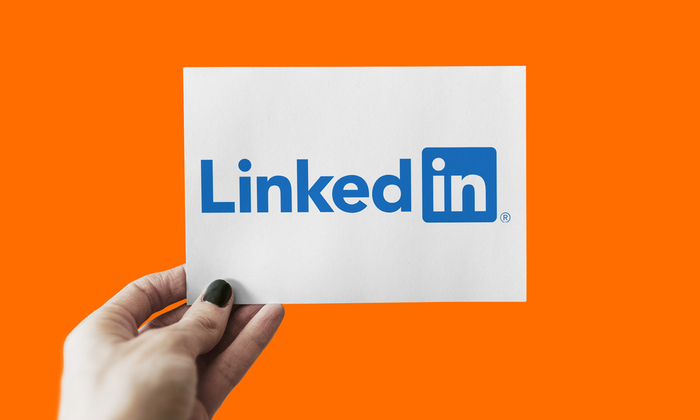
If your business deals with the B2B sector, it’s likely you’ve considered using LinkedIn as an advertising platform to reach your customers.
After all, LinkedIn has become a brilliant social media marketing tool where 774+ million professionals network with each other online.
If you’re in the B2B space, there’s a good chance that your potential customers will be found on the online advertising portal of LinkedIn, and, with a little bit of digging and a lot of target market research – you can reach out to them directly with hopes of generating a lead.
Beware though, recent complaints have kicked up on LinkedIn about “spammy messaging”, “unuseful connections”, and “being sold to constantly.” You need to be smart about your approach, and, above all: provide value to your prospective customers.
In this post, we’re going to explore how you can set up some LinkedIn Ads that will connect you with your target customer – without annoying them. We’ll go through the process of setting up your ad account and also teach you how you can improve your advertising campaign over time, perfecting your messaging, brand voice, and approach.
Are you ready to start using LinkedIn Ads as a potential customer acquisition channel for your business?
Great! Let’s begin.
Step #1: Decide Who You Want to Reach
There’s no denying that LinkedIn’s advertising platform provides you with incredibly powerful targeting capabilities.
However, there’s no point in having access to all of that targeting power if you can’t take full advantage of it and use it towards your overall marketing efforts.
Before you get started creating an ad, you need to spend some time thinking about who your ideal customer is and who you’d like to read.
If you want to be really comprehensive, you should consider creating a buyer persona.
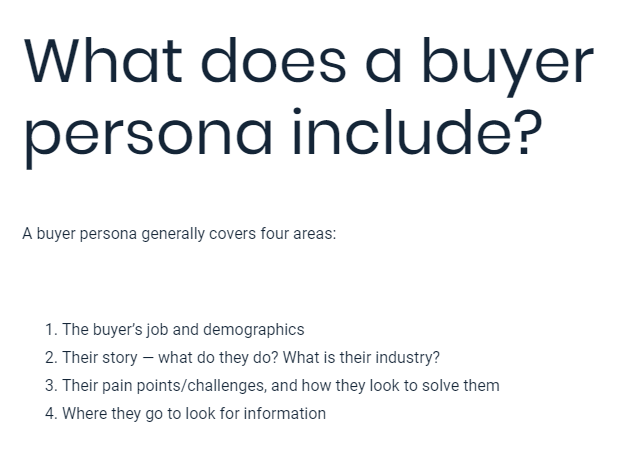
Buyer personas are important for all kinds of marketing plans, and especially when you need to nail down your target audience. They’ve been proven to work and will help you get in the right mindset to create a popular (successful) advert.
When writing up your persona, it should cover the following:
- customer background
- key demographics
- relevant identifiers & buzz words
- ultimate goals
- problems and challenges
- solutions you can offer
When it comes to LinkedIn, there are two ways that you can craft an effective buyer persona that will work:
1. Assessing Current Customers
This is where you simply create a buyer persona that’s based on all of your current customers or customers that you have dealt with in the past. This can be a good way to approach the task if you’ve been in business for a long time and you’re dealing with a market you know well.
2. Identifying Key Traits
The best identifying trait to narrow an audience down on LinkedIn is the job function of your ideal customer. Searching the LinkedIn advertising platform in relation to their job and then analyzing the profiles that come up will help you target users based on presumptions about disposable income – a big consideration for any marketer trying to sell a high-value B2B product or service. You then check out each profile and find patterns that provide you with insight, in terms of the similarities that this specific niche audience might have. These patterns will then help you construct a persona that represents who you should be targeting your advertising campaign towards. This will help you venture into new territory on LinkedIn, and learn more about your target market too.
Step #2: Design Your LinkedIn Ads
Once you’ve found your target audience, congratulations: you’ve done most of the hard work.
Now you need to design LinkedIn Ads that will be particularly effective and resonate with your dream clients.
When using LinkedIn for online advertising, there are many formats that you can utilize to help your digital marketing. Each can be carefully customized to target your demographic.
Let’s take a look at the 2 main advert types.
1. Sponsored Content Ads
Sponsored Content “delivers native ads to the LinkedIn feed of members in your target audience. They can be displayed to LinkedIn members across desktop, tablet, and mobile devices.”
Sponsored Content Ads are a great form of social advertising, and especially if you want your content marketing efforts to go to the right people.
Types of sponsored content ads can be broken into:
- Single Image Ads: These ads include one image and are a simple, effective way of reaching your target audience.
- Carousel Ads: These ads feature a swipeable series of cards. You can showcase multiple offers/products to provide value and insight to your audience.
- Video Ads: These can be published as sponsored content, or through your campaign manager on LinkedIn. They are proven to be particularly effective in recent years, with average consumers watching 100 minutes of video content each day.
While it would be nice to run a brand awareness campaign, many small businesses don’t have the budget to do so. However, for any Sponsored Ad Campaign to be successful, you must have at least one “conversion goal” (or a measurable CTA) in place – no matter how big or small. This will help you calculate how to collect leads once someone engages with your content to make the most of your investment.
2. Text Ads
Text Ads on LinkedIn are separate from content that appears on your feed. They feature in banners and side-tabs and are effective in helping you stand out from the “noise” of social media.

They are easy to design, and, as you can see, aside from targeting, you really only have to focus on copy and images.
Thankfully, it’s pretty easy to test multiple variations of this ad and you can rely on A/B testing to help you come up with a winning ad (more on that later).
When set up properly, Text Ads can deliver great results. However, they are expensive to run.
As an advertising platform, LinkedIn can price their ads higher than standard social media sites because they’re dealing primarily with a B2B market that can afford to pay the higher costs. Additionally, LinkedIn doesn’t have the inventory that you’d find on social networks like Facebook and Google.
This means that more people are competing for less (comparatively) advertising space – driving the prices up.
If you want to take the leap and create a Text Ad, you need to make sure you’ll get a return on investment. Clever Zebo put together some brilliant advice on how to make your advert particularly effective, which we’ll go over now:
- Involve your target audience’s job in the description: Zebo found that this improved click-through rates and reduced the number of ‘curiosity clicks’ on their social ads.
- Use a friendly face: Zebo discovered that using a person’s face in your advert (as opposed to a logo) leads to better results with the campaign.
- Use a clear but conversational tone: Clever Zebo found that clear sentences that sounded natural and conversational worked best for their body copy. They compared results to an overly pushy, “sales style” form of copy and saw a drastic difference. Content marketing experts will always preach the importance of brand TOV when creating blog posts, emails, and content to share on social media so make sure to utilize yours in your adverts.
Step #3: Create and Publish Your LinkedIn Ads
When you have an idea of the advert you want to create, go to your Campaign Manager if you already have an account (or find extra advice on LinkedIn’s Business Solutions to set one up.)
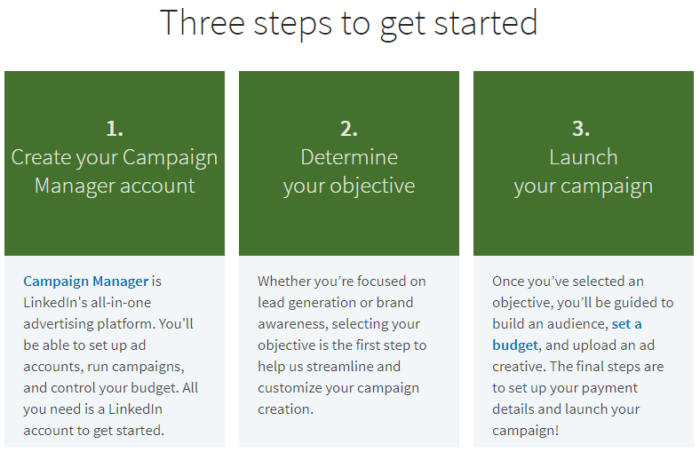
If you want to run Sponsored Content Ads, you’ll need a ‘Showcase page.’
That’s because, with a Sponsored Content advertising campaign, you’re essentially promoting an update that you’ve posted on your company page.
Note: When running a Sponsored Content campaign, there are two kinds –

If you want to, you can run a “Direct Sponsored Content” campaign. This will stop you ‘clogging up’ your company page.
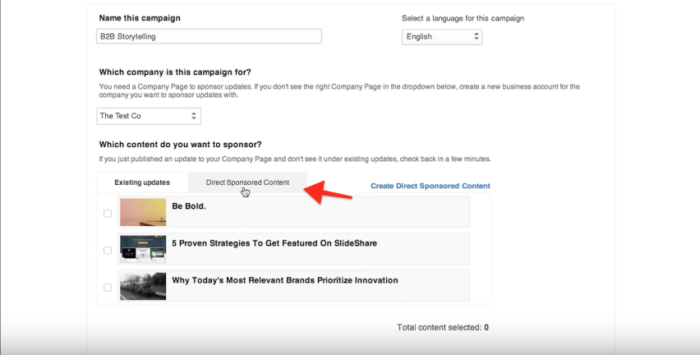
With Direct Sponsored Content, you can create content from within the Campaign Manager.
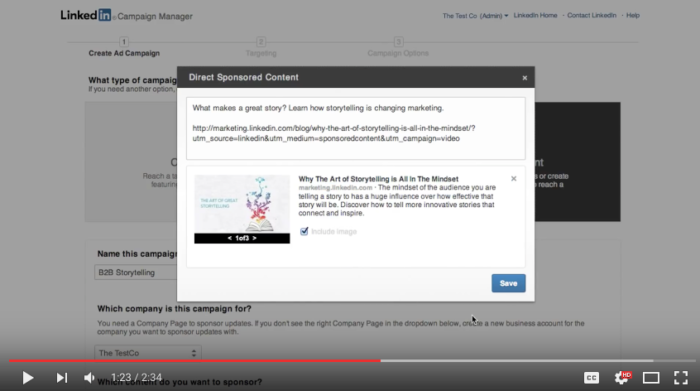
Aside from that, Sponsored Content campaigns and Text Campaigns are relatively similar in how they’re set up.
Let’s now look at setting up a Text Campaign, keeping in mind that what we cover can also be applied to Sponsored Content Ads.
To set up a Text Ad, go back to https://www.linkedin.com/ad/accounts/ and select ‘Text Ads.’
You don’t need a company page for LinkedIn Text Ads.
Give your social ad campaign a name and select your language.
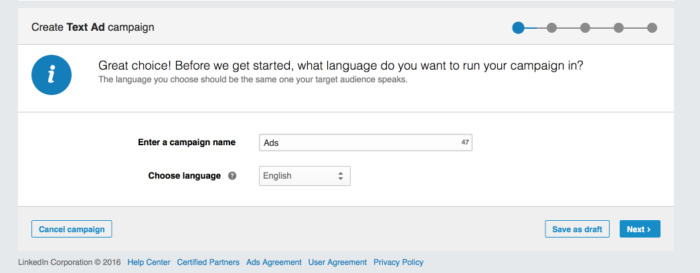
Then, go about creating your ad, using the tips we covered earlier.
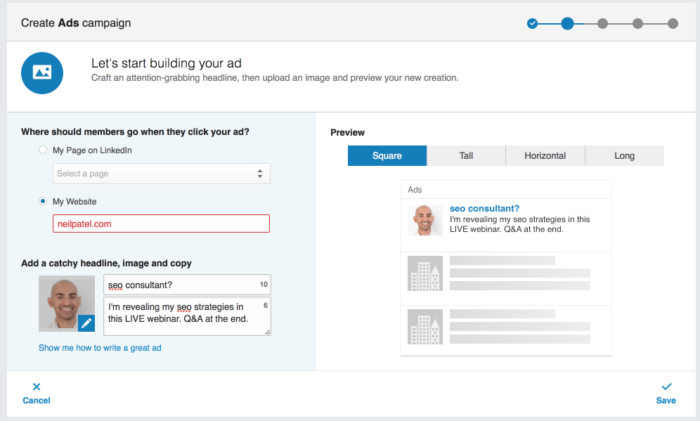
Here are some tips, provided by LinkedIn, related to how you can write better content to improve your online advertising potential. As you can see, the rules are similar for creating great blog posts, Twitter ads, and inspiring online content.
On the right side of the page, you can see some samples of what the ad will look like, when it takes on different sizes.
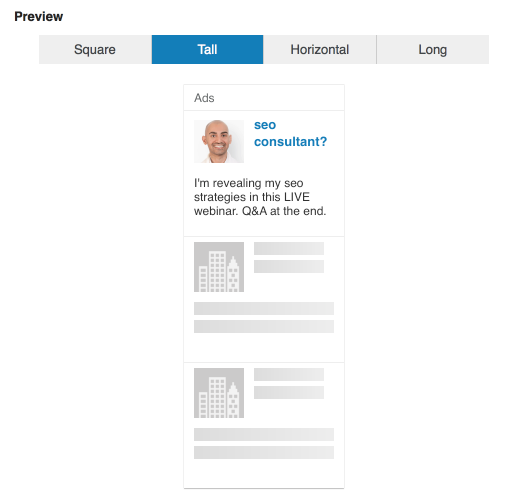
Here’s a Horizontal Ad.
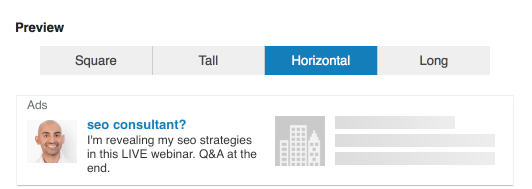
And, a ‘Long’ Ad.
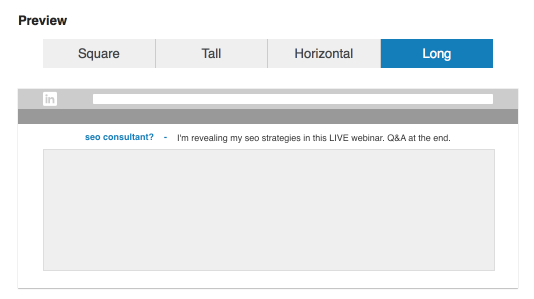
Once you’ve created your first ad, you then have the chance to create more ads. If you’re going to do some split testing, this is where you can create some additional ad variations.

In the next section, you then have the chance to aim your ad at your target audience. This is where you can put your buyer persona data into action and really nail down that marketing strategy.
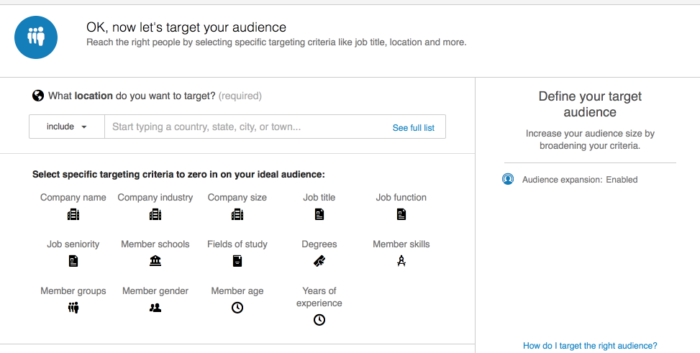
LinkedIn will help you better target your social ads. It will provide suggestions for you, based on the information that you put in.
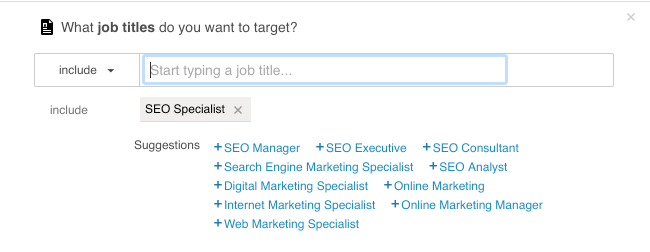
If you look near the bottom of this page, you’ll notice that there is something known as ‘Audience Expansion.’
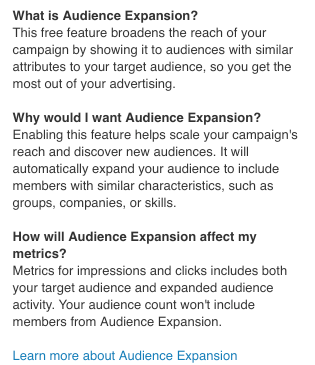
Audience Expansion is a feature that allows for you to target your ads towards people who are similar to the target audience you’re currently targeting – a little like ‘Lookalike Audiences’ from social network giant Facebook.
While this feature might be very effective, consider trying it out only after you first have a winning advertising campaign.
Once you’re finished with the targeting for your campaign, you can then decide how much you’re going to bid for your campaigns.
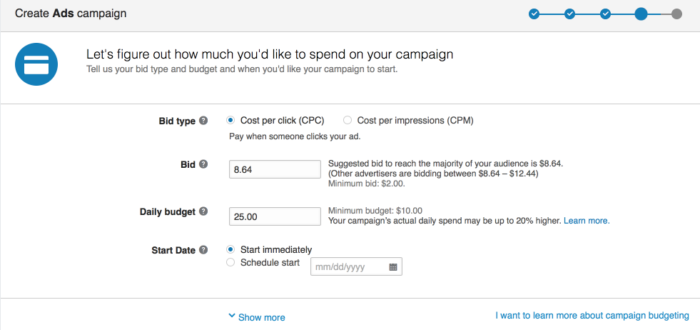
As we mentioned before, the ads on LinkedIn can cost quite a bit. If you know the lifetime value of a customer, however, the price of the ads can be justified as part of your online advertising budget.
There is a minimum bid on LinkedIn of $2.00
You then finally get the chance to approve your campaign and input your billing information.
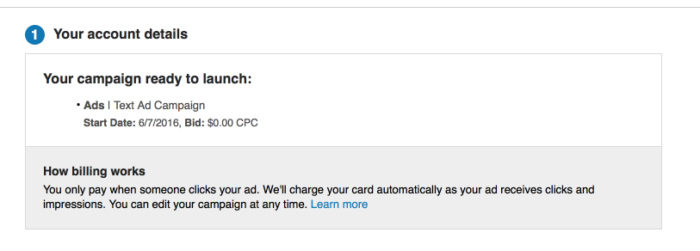
After that, you just need to wait for LinkedIn to approve your campaign and you’ll soon be good to go.
Step #4: Optimize Your Ad Campaigns
As with any ad, you’ll struggle to get people to buy from you right away, and especially if they are unfamiliar with your brand.
In fact, marketing experts estimate audiences need to see something 7 times before they act.
If you are advertising something for the first time, lower your expectations – but also be ready to optimize each and every lead.
How?
By being prepared.
I recommend having an autoresponder sequence in place that books a call with every lead after they follow your CTA, or even sends them to an engaging webinar that you’ve put together.
This will definitely keep your media marketing plan heading in the right direction – and stop leads going cold by involving them in engaging content and intriguing them to work with your brand.
It’s essential to nurture your leads and convert every single one – especially if you are just now being reached out to someone who has seen your adverts 5, 6, or 7 times.
You can’t afford to lose them.
Optimizing your ad campaigns over the long term will help you continually achieve better and better results, as your brand exposure increases.
Split testing can be a huge asset to any marketer desperate to generate leads straight away. You can:
- Try different forms of copy and images on your ad to see what works best and gains the most attention.
- Change your CTA and landing pages. This will give you insight into what your audience responds to best, and where the best conversion rates come from.
- Experiment with calling people who sign up, to see if you can convert them into a customer on a call, as opposed to using an autoresponder to convert them.
- Introduce a webinar or PDF as a lead magnet that educates your customers about what you do and how you can help them.
Remember: if you decide to take the leap and run ads, you have to prepare to expand your campaign by frequently republishing new ad content, trying new ideas, and ultimately investing more money.
Sadly, Text Ads can (and will) fall victim to Banner Blindness.
This is where people become less responsive to your content on advertising platforms and social networks because they’re so used to seeing them. With Text Ads, you’re displaying your ads to a set group of people and new people aren’t being exposed to your ads on a daily basis, as would be the case with a Google Search Ad, for example.
So, your ads can, over time, just blend into the site streams… if you don’t change them on a regular basis.
Step 5: Improve Your Offering
If you find that your LinkedIn Ads are not achieving the levels of engagement that you’d like, or your clicks aren’t converting, you’ll obviously need to make some changes to your brand and content strategy.
Odds are you’re either creating content and blog posts that aren’t appealing to your target audience or your targeting isn’t right.
In most cases, it’ll be that your content isn’t appealing enough.
To create content that will get better levels of engagement, use a tool like Ubersuggest that suggests content types that will work well with your audience.
Once you find winning topics, go about creating something 10x better so your next ad can lead your audience to the perfect website, blog, or final end call.
In doing so, you’ll have created a worthwhile resource, based on a proven topic, that will entice people to make that final sale.
Using LinkedIn Ads to Generate Sales Frequently Asked Questions
Are LinkedIn Ads worth it?
Absolutely! Although LinkedIn charges higher prices than alternative social media platforms, if you are a B2B business wanting to connect with your target audience, it’s the right place to start. However, do bear in mind that adverts can take a while to be successful, and repeat exposure to your brand will increase conversion rates. Prepare your budget accordingly to maximize your campaign results.
What are LinkedIn Ads?
LinkedIn Ads are social media adverts you can customize to your target’s requirements in order to make a sale, or generate a lead. There are 2 main types of LinkedIn adverts: sponsored content and text ads (which appear separately from your audience’s general feed).
Which LinkedIn ad format is the best?
The success of LinkedIn’s ad formats will vary depending on your audience. We recommend creating a buyer persona that will help you understand what your target market responds best to. You can also look at competitors’ ads and similar businesses in the industry to see what type of adverts they are publishing and calculate what works best for you.
What should I advertise on LinkedIn?
LinkedIn is a great platform for any B2B product or service company. Due to the high costs of advertising, we recommend advertising your highest ticket items to maximize ROI.
Using LinkedIn Ads to Generate Sales Conclusion
LinkedIn is an amazing advertising platform to utilize if you want to get your website in front of a B2B audience.
With the help of LinkedIn strategizing, you can do just that, but with laser-targeted precision for your online advertising.
In this post, we’ve gone through the essentials of creating a LinkedIn ad with a step-by-step guide.
We touched on why you need to create a buyer persona and also the different types of LinkedIn Ads and how to optimize each type.
Run some ads of your own, while putting these tips into practice and see if you can get some positive results with LinkedIn Ads.
Do you have any tips you can share when it comes to running LinkedIn ads? Please share below!
from Blog – Neil Patel https://ift.tt/3IOYn2I
via IFTTT
No comments:
Post a Comment